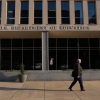Staff and supporters of the Centers for Disease Control and Prevention protested the agency’s budget cuts outside its headquarters in August. Over the past weekend, hundreds of additional employees were laid off.
Dustin Rooms/Bloomberg/Getty Images
hide caption
toggle caption
Dustin Rooms/Bloomberg/Getty Images
About 600 employees at the Centers for Disease Control and Prevention were laid off over the long weekend, part of a broader push by the Trump administration to reduce the size of the federal workforce during the government shutdown.
This has not been a smooth process. On Friday, more than 1,300 CDC employees were notified of the loss of their jobs. Many of them were furloughed due to the shutdown and only found out after Russell Vought, director of the Office of Management and Budget, posted on X that “RIFs have begun.”
The next day, about 700 employees received emails revoking those reduction notices, according to figures compiled by the National Public Health Coalition, a group of former CDC employees.

Aryn Melton Backus, a health communications specialist in the CDC’s Office on Tobacco and Health who has been on administrative leave for months, was one of them. It was the third time this year that she received a termination notice.
“We have no idea why some programs were eliminated and others were saved,” Backus said at a Tuesday news conference hosted by NPHC. “At this point, it appears that chaos and lack of transparency are at the root of the problem.”
In a court filing Tuesday, the Department of Health and Human Services attributed some of the rapid layoffs and cancellations to “data discrepancies and processing errors.”
After the dust settled, about 600 CDC employees were laid off over the weekend, according to the Former CDC Employees Group and AFGE Local 2883, a union that represents CDC workers.

Among those laid off are CDC staff who brief Congress, those who work on health statistics and chronic diseases. It also affected CDC support staff, such as those in the CDC library, those who provided mental health support after an attack on the CDC’s main campus in August, and human resources staff who were called back from leave to lay off colleagues and members of their own team.
HHS declined to confirm the number or groups affected by this round of layoffs, but Andrew Nixon, communications director, said the laid-off employees were “designated as non-essential.”
The court filing says that as of Oct. 10, a total of 982 employees were deliberately removed from HHS, which includes agencies such as the Substance Abuse and Mental Health Services Administration and the Administration for Strategic Preparedness and Response, in addition to the CDC.
The Federal National Workers Union is challenging the legality of these and other layoffs.
“These illegal layoffs of our union members during a federal government shutdown are a brutal attack on American workers and put the livelihoods, health and safety of our members and communities at grave risk,” said Yolanda Jacobs, CDC health communications specialist and president of AFGE Local 2883, speaking at a union news conference Tuesday.
The recent round of cuts adds to the flow of workers leaving the CDC this year due to previous rounds of layoffs, early retirements and resignations. The CDC has lost around 3,000 employees, or a quarter of its workforce, since January according to the union.
The entire staff of the CDC’s Washington office was eliminated in recent cuts, upending a long-standing support system for congressional representatives.
“CDC has worked directly with Congress for decades to help its constituents by providing data, expertise and information when needed,” Dr. John Brooks, who retired last year as chief medical officer of the CDC’s HIV prevention division, said at the NPHC press conference. “These layoffs mean Congress no longer has a way to directly access the agency it funds when it needs information or briefings.”
Outside of the Washington office, CDC policy experts who help develop briefings and answer questions from Congress have also been eliminated, according to the NPHC.
Overall, cuts to the CDC’s staff and budget under the Trump administration are damaging the nation’s public health infrastructure, Brooks says. “Many experts, including myself, fear that we are no longer well prepared for the next major epidemic or disaster because of the Trump administration’s continued erosion of our nation’s capacity to respond to public health emergencies.”
State and local health departments are feeling the effects. When faced with problems such as food poisoning outbreaks or hospital infections, they have traditionally sought help from the CDC.
“Sometimes that help might be — we’ll send people to help you investigate this. Sometimes that might be talking to someone who is the world expert on a specific type of infection or exposure,” Dr. Karen Remley, a former CDC official and former Virginia health commissioner, said at the NPHC news conference. “Now there is no one to answer the phone.”
In an email, HHS’s Nixon described the federal health care infrastructure as a “bloated bureaucracy” and said, “HHS continues to close unnecessary and redundant entities in order to streamline the agency for the American people.” »








